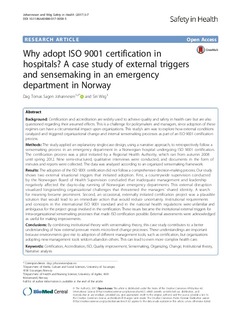| dc.contributor.author | Johannesen, Dag Tomas Sagen | |
| dc.contributor.author | Wiig, Siri | |
| dc.date.accessioned | 2018-04-11T09:23:05Z | |
| dc.date.available | 2018-04-11T09:23:05Z | |
| dc.date.created | 2017-08-22T16:01:52Z | |
| dc.date.issued | 2017-07 | |
| dc.identifier.citation | Johannesen, D.T.S., Wiig, S. (2017) Why adopt ISO 9001 certification in hospitals? A case study of external triggers and sensemaking in an emergency department in Norway. Safety in health, 2017, 3 (7), . | nb_NO |
| dc.identifier.issn | 2056-5917 | |
| dc.identifier.uri | http://hdl.handle.net/11250/2493590 | |
| dc.description.abstract | Background
Certification and accreditation are widely used to achieve quality and safety in health care but are also questioned regarding their assumed effects. This is a challenge for policymakers and managers, since adoption of these regimes can have a circumstantial impact upon organizations. This study’s aim was to explore how external conditions catalyzed and triggered organizational change and internal sensemaking processes as part of an ISO 9001 certification process.
Methods
The study applied an explanatory single-case design, using a narrative approach, to retrospectively follow a sensemaking process in an emergency department in a Norwegian hospital undergoing ISO 9001 certification. The certification process was a pilot initiated by a Regional Health Authority, which ran from autumn 2008 until spring 2012. Nine semi-structured, qualitative interviews were conducted, and documents in the form of minutes and reports were collected. The data was analyzed according to an organized sensemaking framework.
Results
The adoption of the ISO 9001 certification did not follow a comprehensive decision-making process. Our study shows two external situational triggers that initiated adoption. First, a countrywide supervision conducted by the Norwegian Board of Health Supervision concluded that inadequate management and leadership negatively affected the day-to-day running of Norwegian emergency departments. This external disruption visualized longstanding organizational challenges that threatened the managers’ shared identity. A search for meaning became prominent. Second, an occasional, externally initiated certification project was a plausible solution that would lead to an immediate action that would reduce uncertainty. Institutional requirements and concepts in the international ISO 9001 standard and in the national health regulations were unfamiliar and ambiguous for the project group involved in the certification. These issues became the institutional external triggers for intra-organizational sensemaking processes that made ISO certification possible. External assessments were acknowledged as useful for making improvements.
Conclusions
By combining institutional theory with sensemaking theory, this case study contributes to a better understanding of how external pressure meets micro-level change processes. These understandings are important because environments give rise to adoption of different management tools, such as certification, but organizations adopting new management tools seldom abandon others. This can lead to even more complex health care. | nb_NO |
| dc.language.iso | eng | nb_NO |
| dc.publisher | BioMed Central | nb_NO |
| dc.rights | Navngivelse 4.0 Internasjonal | * |
| dc.rights.uri | http://creativecommons.org/licenses/by/4.0/deed.no | * |
| dc.subject | ISO-sertifisering | nb_NO |
| dc.subject | institutional theory | nb_NO |
| dc.subject | accreditation | nb_NO |
| dc.title | Why adopt ISO 9001 certification in hospitals? A case study of external triggers and sensemaking in an emergency department in Norway | nb_NO |
| dc.type | Journal article | nb_NO |
| dc.type | Peer reviewed | nb_NO |
| dc.description.version | publishedVersion | nb_NO |
| dc.rights.holder | © The Author(s). | nb_NO |
| dc.subject.nsi | VDP::Medical disciplines: 700::Health sciences: 800 | nb_NO |
| dc.source.pagenumber | 14 | nb_NO |
| dc.source.volume | 3 | nb_NO |
| dc.source.journal | Safety in health | nb_NO |
| dc.source.issue | 7 | nb_NO |
| dc.identifier.doi | 10.1186/s40886-017-0058-5 | |
| dc.identifier.cristin | 1487959 | |
| dc.relation.project | Universitetet i Stavanger: 7291 | nb_NO |
| cristin.unitcode | 217,7,5,0 | |
| cristin.unitcode | 217,13,0,0 | |
| cristin.unitname | Institutt for medie- og samfunnsfag | |
| cristin.unitname | Det helsevitenskapelige fakultet | |
| cristin.ispublished | true | |
| cristin.fulltext | original | |
| cristin.qualitycode | 1 | |

